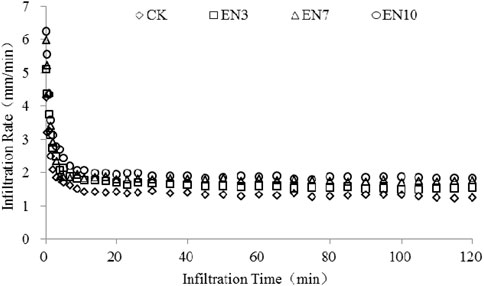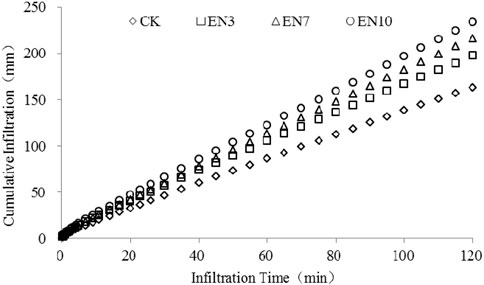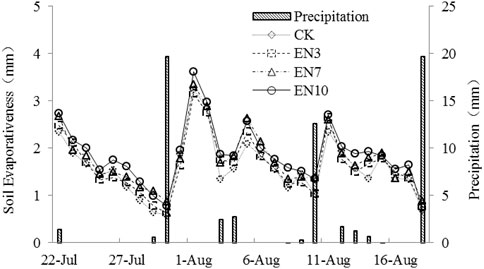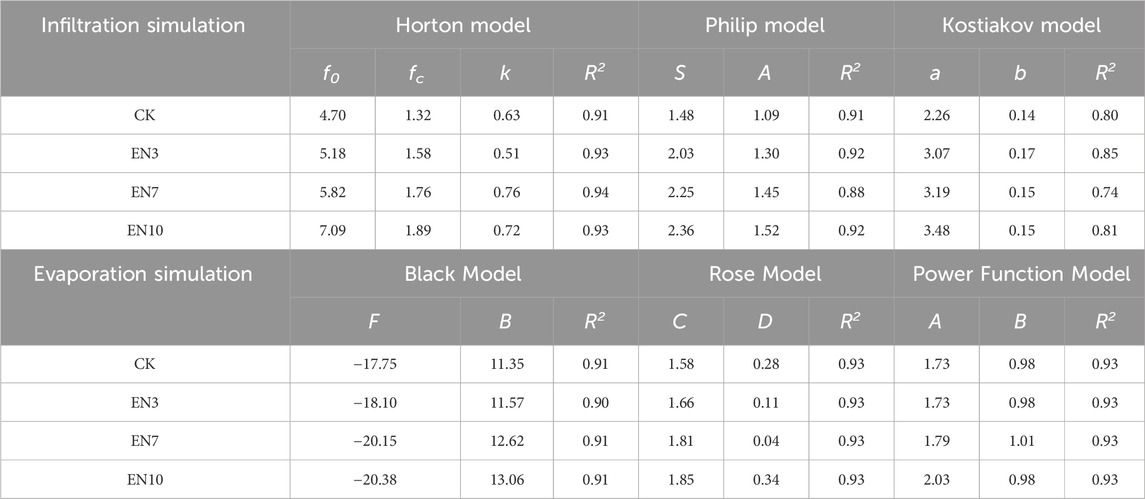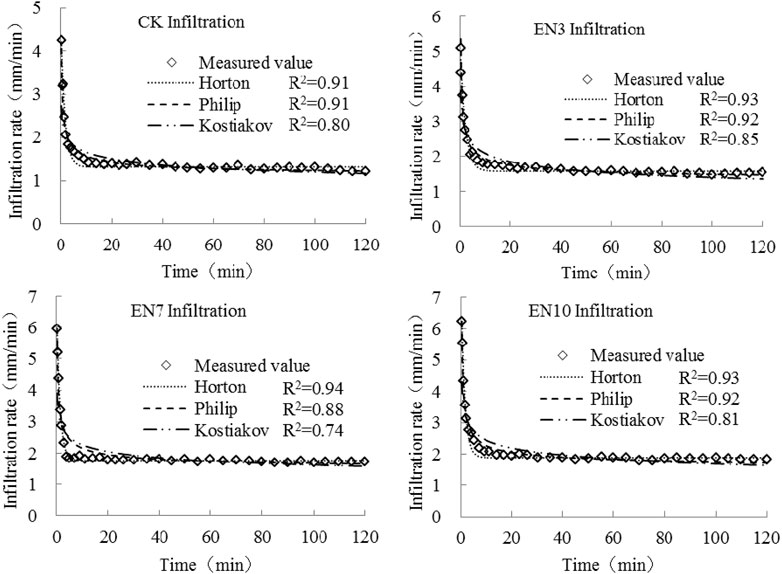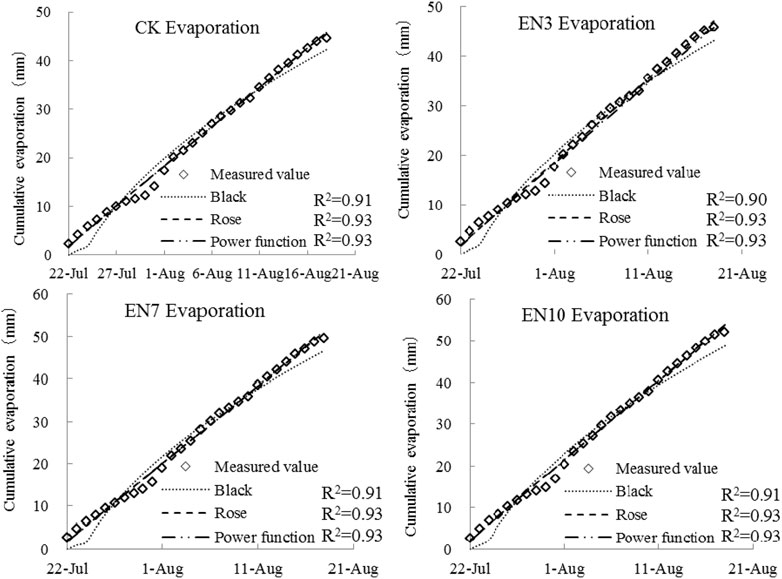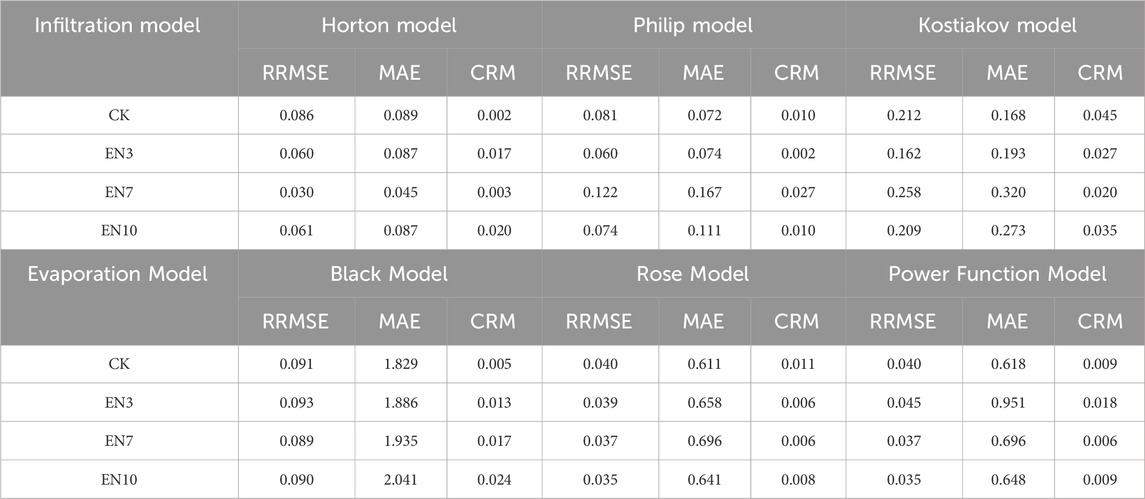Effects of enclosure measures on soil water infiltration and evaporation in arid and semi-arid grassland in northern China
- 1College of Desert Science and Engineering, Inner Mongolia Agricultural University, Hohhot, Inner Mongolia, China
- 2College of Geographic and Planning, Jining Normal University, Ulanqab, Inner Mongolia, China
- 3College of Water Conservancy and Civil Engineering, Inner Mongolia Agricultural University, Hohhot, Inner Mongolia, China
Soil infiltration and evaporation are the main factors affecting the water cycle in arid and semi-arid areas, and the sealing measures determine the soil water storage capacity by affecting the evaporation and infiltration process of grassland soil water, which is the key to the ecological environment restoration of arid and semi-arid grassland. This study taking the enclosure time of Hulunbuir grassland for 3 years, 7 years, 10 years and the grazing control grassland as the research objects by using small evaporation instrument and double-ring infiltration instrument.To study the effects of enclosure measures on soil water distribution, soil infiltration and evaporation, and to evaluate the applicability of the main soil evaporation and infiltration models in enclosed grassland. The results show that (1) the enclosure measures can effectively improve the soil water content. In the vertical direction, the soil water content shows a trend of increasing first and then decreasing. (2) The initial infiltration rate and stable infiltration rate of grassland at different enclosure time are significantly different (P<0.05), and the soil infiltration rate and evaporation rate were in the order of EN10 >EN7 >EN3 >CK. (3) Using three infiltration process models to simulate the grassland infiltration process at different enclosure times, the Horton model is able to better model the inflection points of the infiltration process, and the fit accuracy is higher than that of the Philip and Kostiakov models. (4) The cumulative evaporation process of grassland at different closure times was simulated by using Black, Ross, and Power function models.The simulation values calculated by the Rose model are the closest to the measured value, and the simulation accuracy is the highest.The comprehensive analysis shows that the hydrological characteristics of grassland soil change significantly in the early stage of enclosure phase, and the soil properties have reached a good state for 3 to 7 years.With the continuous increase of enclosure time, the change of soil hydrological characteristics is not obvious. The results are helpful for soil and water conservation and ecological environment management in arid and semi-arid grassland.
Introduction
Water is the key controlling factor of vegetation growth, which directly affects the growth and development of vegetation (Chamizo et al., 2013). Soil infiltration and evaporation is not only an important part of the surface water cycle in semi-arid regions, but also a link between surface water, underground water and atmospheric water. The magnitude of soil water infiltration rate and the strength of evaporation capacity directly affect the soil water content (Guan and Cao, 2019). In semi-arid grassland areas, precipitation is small, evaporation is large, and available water for vegetation is limited. The growth of vegetation mainly depends on the water entering into the soil, and the soil evaporation capacity and infiltration performance directly affect the amount of soil water, and then indirectly control the growth trend of grassland vegetation (Zhang, 2021). In Hulunbuir grassland, due to the influence of climate change and unreasonable grazing activities, the vegetation coverage, biodiversity and ecological service function of grassland are decreased, and the large area of grassland was degraded as a whole (Nie et al., 2021). Grassland enclosure is a simple and effective way to restore degraded grasslands. In the process of closure and restoration, the growth and development of grassland vegetation is limited by soil water. With the increase of enclosure times, the change of vegetation community structure will alter the soil texture and water supply conditions and further affect soil infiltration and evaporation. Therefore, exploring the effects of enclosure measures on the soil infiltration and evaporation process of grassland, and determining the optimal enclosure period for soil water conservation, is the key to restoring the ecological environment of semi-arid grassland.
The soil water infiltration process determines the ability of precipitation to transform into soil water, while the soil evaporation process determines how much infiltration water can be retained in the surface soil for use. Infiltration and evaporation directly affect soil water content and vegetation water utilization efficiency (Yu et al., 2010; Jiao et al., 2017). In recent years, numerous researchers at home and abroad have studied the process of soil infiltration and evaporation under different environmental conditions, mainly focusing on soil infiltration and evaporation processes under the influence of human factors in agricultural planting environment (Bristow et al., 2020; Cui et al., 2021), among which the use of external additives such as biochar (Sun et al., 2019), fly ash (Yang et al., 2020) and bioactive agent (Saad, 2018) to change the soil texture and affect the movement of soil water. A large number of studies have been carried out to clarify the effects of external additives on soil evaporation and infiltration; At the same time, some researchers discussed the effects of residual agricultural film (De Souza Machado et al., 2018) and soil microplastics (Wan et al., 2019) on soil infiltration and evaporation, and constructed empirical and semi-empirical models to simulate the evaporation infiltration process of agricultural film soil and microplastic soil, and explained the effect of residual film and microplastics on soil water transport by blocking pores (Machado et al., 2019). At present, the research on soil infiltration and evaporation process and its influencing factors is mainly focused on the agricultural planting soil environment in various types of farming areas (Liao et al., 2021). While, there have been relatively few studies of meadow grassland soils in semi-arid regions, where the ecological environment is relatively fragile, the geographic spatial span is distinct, and the ability to resist disturbance is weak. The source of soil water in semi-arid grasslands is single. How to maintain soil water and reduce ineffective evaporation is the key to the healthy growth of grassland vegetation. Through field measurement and indoor simulation.
The Hulun Buir grassland is located in the interior of northern China. Long-term unreasonable grazing activities have led to grassland vegetation degradation, soil desertification and habitat fragmentation. As an effective means of grassland restoration, enclosure measures can improve the structure of vegetation groups, conserve water sources, maintain water and soil, and ensure the healthy growth of grassland vegetation. This paper takes grazing grassland and enclosed grassland in Hulun Buir meadow grassland for 3, 7 and 10 years as the research objects. Through field measurements and indoor simulations, the effects of enclosure period on soil infiltration and evaporation characteristics of grassland were studied, and the simulation processes of main infiltration and evaporation models were evaluated, so as to provide a theoretical basis for soil and water conservation and ecological environment control of meadow grassland in arid and semi-arid areas.
Materials and methods
Overview of the study area
This research area is located in Baodong Sumu, Xinbarhu Banner, Hulun Buir City, Inner Mongolia (N 48°27′54.95″∼48°28′33.07″, E 117°11′41.26″∼117°16′19.68″). It belongs to the hinterland of the Hulun Buir grassland and is about 30 km nearby Hulun Lake. Located in northeastern Inner Mongolia, it belongs to the semi-arid continental climate zone of the Northern temperate zone. The mean annual temperature ranges from −0.6°C to 1.1°C, and the annual sunshine duration ranges from 2,694 to 3,131 h. The average annual precipitation ranges from 240.5 to 283.6 mm and is mainly concentrated from July to September, accounting for over 60% of the annual precipitation, the annual average evaporation rate ranges from 1455.3 to 1754.3 mm and the annual frost-free period of 110–160 days. The soil composition is mainly sandy soil and sandy loam with loose structure and low fertility (Fan and Wang, 2021). The main plant species in the study area are: Leymus chinensis, Cleistogenes squarrosa, Stipa sareptana, Artemisia frigida and other vegetation (Fan and Wang, 2021).
Sample collection and processing
From July to August 2021, the soil evaporation experiment and infiltration simulation experiment were selected in the research area for 3 years (EN3), 7 years (EN7), 10 years (EN10) and grazing control (CK) grasslands in the research area. Of these, the closed grassland showed severe degradation prior to closure. The grazing intensity of the control grassland is heavy grazing, and the livestock carrying rate is 610∼680 sheep/km2. Following the grid arrangement method, grid points were established at intervals of 500 m for closed and controlled grassland, 13 points for EN3 grassland, 12 points for EN7 grassland, 15 points for EN10 grassland and 9 points for heavy grazing grassland, in which soil samples were collected and analyzed. According to the requirements of “soil agrochemical analysis,” the sampling points were set up by X distribution method and triangle distribution method at each survey site. 0∼30 cm soil samples and ring knife samples were collected in three layers at each sampling point. After soil samples were layered and mixed, 500 g soil samples were retained by quarter method, the soil samples were sifted by 1 mm and 0.25 mm. After screening, put it in a sealed pocket for preservation, and take it back to the laboratory to determine the physical and chemical indicators such as soil texture composition, soil volume, porosity, and organic matter. The basic properties are shown in Table 1. Soil evaporation experiment and double ring infiltration experiment were carried out at three points with similar physical structure in different enclosed grasslands, and the evaporation and infiltration performance of soil was measured. At the same time, a portable small automatic weather station is set up in the study area to observe air temperature, humidity, wind speed, solar radiation, air pressure, soil water content and other meteorological indicators, and automatically record data per 30 min.
Evaporation experiment
In this study, the soil evaporation experiment was carried out by using small lysimeter, which is a PVC sleeve with inner diameter 10 cm and height 15 cm, with a leak-proof yarn net at the bottom, which is a self-developed Chinese national patent (patent number ZL201620486286.3). For the experiment, 28 typical days were selected from 22 July to 18 August 2016 and the soil evaporation was measured at 7:00 and 19:00. Weighing the soil evaporation with a precision of 0.01 g of electron equilibrium, the mass conservation principle is used to calculate the soil evaporation. At the same time, the parameters of soil temperature and the moisture content were measured.
Infiltration experiment
In this study, the soil water infiltration rate was measured by using double-ring infiltration instrument with an inner diameter of 50 cm and an outer diameter of 80 cm. Before the start of the experiment, the grassland was pruned and the topsoil herbaceous plants were cut off, after which the infiltration ring was slowly penetrated into the soil layer with an energy-absorbing hammer to keep the soil from being damaged. Finally, we began the soil infiltration experiment, using Markov bottle to inject water into the infiltration ring, keeping the infiltration head at a constant height of 5 cm, always paying attention to the water level between the two rings, ensuring flattening, and preventing the lateral infiltration of water in the inner ring. The water level scale of the Markov bottle was read at 0, 30, 60, 120, 180 s, 5 min, 7 min, 10 min, 15 min, 25 min, 30 min, and every 10 min after the start of the experiment. The infiltration temperature and salinity were measured simultaneously until the end of the two-hour period. Three sets of repeated experiments were performed at three infiltration test sites in grasslands with different enclosure periods and control grasslands, and the characteristic curves of soil water infiltration were measured in the closed grasslands. At the same time, prior to the start of the infiltration experiment, the soil around the infiltration point was drilled to determine the initial water content, with a sampling range of 0–60 cm.
Evaporation model and infiltration model
Horton model, Philip model and Kostiakov model were used to simulate grassland soil infiltration (Niu et al., 2016), and Black model, Rose model and Power function were used to simulate grassland soil cumulative evaporation (Wang et al., 2017). The effect of the enclosure time on soil infiltration and evaporation is discussed.
(1) The relationship of Horton infiltration model is as follows:
In the formula, f(t) is the infiltration rate (mm/min); t is the infiltration time (min); f0 is the hypothetical initial infiltration rate (mm/min); fc is the hypothetical stable infiltration rate (mm/min); k is the empirical constant.
(2) The relationship of Philip infiltration model:
In the formula, f(t) is the infiltration rate (mm/min), t is the infiltration time (min), S is the soil water absorption rate (mm/min), A is the stable infiltration rate (mm/min).
(3) The relationship of Kostiakov infiltration model:
In the formula, f(t) is the infiltration rate (mm/min), t is the infiltration time (min), and a and b is an empirical constant.
(4) The relationship of Black evaporation model:
In the formula, E is the cumulative evaporation (mm), t0 is the evaporation duration (d), F and B are evaporation parameters.
(5) The relationship of Rose evaporation model:
In the formula, E is the cumulative evaporation (mm), t0 is the evaporation duration (d), C is the stable evaporation parameter, and D is the water diffusion parameter.
(6) The relationship of power function model:
In the formula, E is the cumulative evaporation (mm), t0 is the evaporation duration (d), A and B are evaporation parameters.
Data analysis and processing
Statistical analysis of the measurements was performed using excel2010 and SPSS20.0 software. Relative root mean square error (RRMSE), mean absolute error (MAE), group residual coefficient (CRM) and determination coefficient (R2) are used as the evaluation index of the simulation effect of the model. The smaller the RRMSE, MAE and CRM values are, the closer R2 is to 1, and the better the model simulation effect is.
Results
Soil water distribution characteristics of different enclosed grasslands
Based on the analysis of the distribution characteristics of soil water in grasslands with different closure periods, Figure 1 shows that the soil water content initially increases and then decreases as the soil depth increases. The soil water content of the CK grassland ranges from 9.36% to 12.72%, with a water variability coefficient of 0.02–0.05. EN3 grassland soil water content ranges from 10.10% to 13.50%, the coefficient of water variation is between 0.02 and 0.07; The soil water content of the EN7 grassland ranges from 10.71% to 13.37%, and the coefficient of water variation is between 0.01 and 0.05; The soil water content of the EN10 grassland ranges from 10.36% to 13.92% and the coefficient of water variation is between 0.02 and 0.07. Except for the EN10 grassland, where the maximum soil water content occurs in layers of 20–30 cm, the maximum soil water content in other grasslands occurs in layers of 10–20 cm, and the minimum soil water content occurs in layers of 50–60 cm. The vertical distribution of soil water in the grassland showed significant differences under different disturbance measures, with enclosure measures having a large impact on the soil water content. Compared with grazing grassland, the soil water content in enclosed grassland was significantly higher than that in grazing grassland (p < 0.01). Compared with CK grassland, the soil water accumulation distribution area of CK grassland is mainly concentrated in10∼20 cm, the soil water accumulation distribution area of EN3 and EN7 grassland is 10∼30 cm, EN10 grassland soil water accumulation region 20∼50 cm, and the soil water content showed as EN10 > EN7 > EN3 > CK.
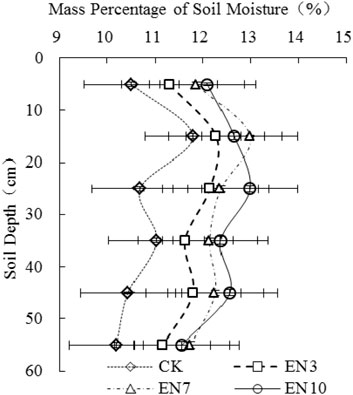
Figure 1. The vertical distribution of soil water in grassland with different years of enclosure. Data are the mean ± SD.
Soil infiltration process in different enclosed grassland
Double-ring infiltration experiments with a 5 cm water head were performed on enclosed grasslands and grazing grasslands, and the soil infiltration properties of the grasslands were measured under different interference measures, as shown in Figure 2. At the beginning of the infiltration process, the water percolates rapidly and the soil water infiltration rate rapidly decreases to 40% of the initial infiltration rate within 3–5 min. As the infiltration time increases, the downward trend of the infiltration rate slows down and gradually stabilizes at 14–20 min. The shift law is the same for soil infiltration rates in closed and grazing grasslands. There was no significant difference in initial soil infiltration rate between EN10 grassland and EN7 grassland under the same water head (p > 0.05), but there was significant difference in stable infiltration rate among different treatments (p < 0.01). By comparing the initial infiltration rate and stable infiltration rate of EN3, EN7, NE10 and CK, it was found that there were significant differences (p < 0.05) in initial infiltration rate and stable infiltration rate of different closed time grasslands under the same infiltration head. The overall results show that EN10 grassland is the largest, EN7 grassland is the second largest and EN3 grassland is the smallest. The initial infiltration rate of EN3 grassland was 5.10 ± 0.12 mm/min, and the stable infiltration rate was 1.57 ± 0.21 mm/min, which was 20.3% and 19.7% higher than that of CK grassland, respectively. The initial infiltration rate of EN7 grassland was 5.95 ± 0.17 mm/min, and the stable infiltration rate was 1.76 ± 0.28 mm/min, which was 40.5% and 33.9% higher than that of CK grassland, respectively. The initial infiltration rate of EN10 grassland was 6.23 ± 0.11 mm/min, and the stable infiltration rate was 1.88 ± 0.23 mm/min, which was 47.1% and 43.4% higher than that of CK grassland, respectively. The closure measures can effectively increase the infiltration rate of the grassland soil and accelerate the supply of water to this area.
Cumulative infiltration is the total amount of infiltrated water per unit area of the surface over a certain period of time, and the cumulative infiltration of grassland with different disturbance measures has been analyzed and can be seen in Figure 3. There was a significant difference in cumulative infiltration between different closure periods and grazing grasslands under the same water head (p < 0.05). The cumulative infiltration amount of EN10 grassland was considerably higher than that of other closed time grasslands, which was 233.41 ± 3.27 mm, 1.43 times of CK grassland, 216.44 ± 5.73 mm of EN7 grassland, 1.33 times of CK grassland, 197.23 ± 5.14 mm of EN3 grassland, 1.21 times of CK grassland. Enclosing can be effective in increasing soil water infiltration and improving water supply conditions for grassland vegetation, but the rate of increase in grassland water infiltration decreases with the length of enclosure. Therefore, grazing grasslands can alter the soil infiltration status and restore soil infiltration capacity with appropriate enclosure measures.
Evaporation process of different enclosed grassland
Soil evaporation was analyzed in grasslands and grazing grasslands with different enclosure periods from July 22 to August 18. As shown in Figure 4, the change law of soil evaporation of the grassland with different disturbance measures was the same, showing a fluctuating state, and the soil evaporation rate showed EN10 > EN7 > EN3 > CK. The cumulative soil evaporation in EN10 grassland was the highest at 52.19 mm, which was 1.05, 1.14, and 1.17 times higher than that of EN7 grassland, EN3 grassland, and CK grassland respectively. The cumulative soil evaporation of EN3 grassland was close to that of CK grassland, which was 45.91 mm and 44.65 mm, respectively, and the difference was not significant (p > 0.05). During the observation period, there were four peaks in daily soil evaporation in the grassland, all of which occurred after rainfall events, with the largest daily evaporation occurring on 1 August, which could reach 3.15–3.62 mm/d. It can be seen that this phase is primarily a control phase of atmospheric evaporation. As a result of the rainfall on 30 July, the soil water content increased substantially and approached saturation. The coefficient of variation for soil evaporation in each enclosed grassland exceeds 0.3, with the CK grassland exhibiting the highest coefficient of variation at 0.39. Additionally, EN3 grassland shows a coefficient of variation of 0.37, while EN7 and EN10 grasslands exhibit coefficients of variation of 0.34 each. These findings indicate that different treatments applied to the grasslands are significantly influenced by external factors, resulting in greater variability and diversity in soil evaporation patterns, aligning with the general principles governing soil evaporation.
Simulation of soil infiltration and evaporation in different enclosed grasslands
The calculated parameters of the model are given in Table 2. In the simulation of the infiltration process, the Horton model parameter f0 represents the initial infiltration rate, which ranges from 4.7 to 7.09. fc are stable infiltration rates, ranging from 1.32 to 1.89. The value of k, a soil characteristic parameter, varies widely among closed grasslands, with a coefficient of determination R2 ranging from 0.91 to 0.94. The parameter A in the Philip model represents the steady infiltration rate, and S represents the initial infiltration rate. Affected by the initial water content in the soil, the initial water content of each closed grassland is significantly different (p < 0.05), and the determination coefficient R2 is between 0.92 and 0.99. In Kostiakov model, parameter a represents the speed of infiltration rate decay, EN10 grassland infiltration rate attenuates fastest and reaches stability at first, b represents the trend of soil infiltration rate changing with time, its variation range is 0.14∼0.17, the variation range is tiny, and the determination coefficient R2 is between 0.74 and 0.85. In the simulations of the cumulative evaporation process, the Black model F is the regulation coefficient and B represents the rate of soil evaporation, which ranges from 11.35 to 13.06. CK and EN3 grasslands have smaller values of B, and EN10 grasslands have rapid changes in soil evaporation. The coefficient of determination R2 for this model is between 0.90 and 0.91. The Ross model parameter C represents the steady evaporation rate and D represents the water diffusion rate. The stable evaporation dimension of grassland at different enclosure periods is 1.58–1.85 and the difference in water diffusion is large. The EN7 grassland has the smallest water diffusion rate, with a determination coefficient R2 of 0.93. The parameters A and B of the Power function model are varied by one bit, and the coefficient of determination R2 of the model is also 0.93. Further evaluation of the simulation effects of the two models is needed.
The fit effects of the three infiltration models are analyzed. As shown in Figure 5, the measured values of the soil infiltration process are compared with the calculated values of the three infiltration models. The simulation effect of Horton model on water infiltration process of three kinds of enclosed grassland and grazing grassland is excellent, the initial infiltration rate and stable infiltration rate are close to the measured values, the relative error of initial infiltration rate is less than 0.76%, and the relative error of stable infiltration rate is less than 0.94%. The Horton model is able to better model the inflection point of the infiltration process during the infiltration transient phase. The Philip model is second only to the Horton model for the simulation of the initial infiltration rate and the steady infiltration rate, with relative errors of less than 5.01 percent and 1.94 percent, respectively, but the transient inflection point model performs poorly. The Kostiakov model has a poor simulation for the initial infiltration rate, with a relative error of more than 23.9 percent for the initial infiltration rate, and a relatively good simulation for the steady infiltration rate, with a relative error of less than 2.1 percent. The simulation results of the three models are close to those of the steady infiltration and can better simulate the steady infiltration phase.
We analyze the effect of fitting the three evaporation models. It can be seen in Figure 6 that the measured values of the cumulative evaporation process of the soil are compared with the calculated values of the three evaporation models. The Black model exhibits some bias in simulating cumulative evaporation for enclosed grasslands and grazing grasslands, with a downward shift in the starting point and a relative error ranging from 5.27% to 6.67%. In contrast, both the Rose model and Power function model provide relatively more favorable simulations, accurately capturing initial evaporation rates and final accumulation values of cumulative evaporation. The error between simulated and measured values for the Rose model ranges from 2.67% to 3.08%, while that for the Power function model is between 0.15% and 3.52%.
Three infiltration models and three evaporation models can simulate the evaporation process and infiltration process of grassland soil in arid and semi-arid areas, but there are certain differences in the final simulation effect. The simulation effect of some models is relatively close, and it is impossible to judge the advantages and disadvantages of the model intuitively. Therefore, the simulation effect of the infiltration model and evaporation model is evaluated by using the relative mean square root error RRMSE, average absolute error MAE and the whole group residual coefficient CRM. As can be seen from Table 3, the RRMSE of the Horton model is lower than the Philip model and the Kostiakov model in the three enclosure time grasslands, and only higher than the Philip model in the grazing grassland, but lower than the Kostiakov model; MAE in the grazing grassland and the enclosure 3-year grassland is higher than the Philip model, but lower than the Kostiakov model, which is the lowest in both 7 years of enclosed grasslands and 10 years of enclosed grasslands; the Horton model is lower than 0.1 in the CRM of CK and EN7 grassland, with a maximum value of 0.2, while the Philip model is only lower in EN3 grassland, the maximum value is 0.27. And the CRM value of the Kostiakov model is greater than 0.2. For the simulation of soil cumulative evaporation process of the three models, the RRMSE and MAE of the Black model are higher than the Rose model and the Power function model, and the RRMSE and MAE of the Rose model are less than or equal to the Power function model. Except for grazing grassland, the CRM of the Black model is higher than the Rose model and the Power function model. The CRM of the Rose model in CK is higher than the Power function model, and the rest is lower than the Power function model. The simulated value of soil water infiltration process calculated by Horton model is the closest to the measured value, and the simulation accuracy is the highest. The simulation value of the soil water accumulation evaporation process calculated by the Rose evaporation model is the closest to the actual measured value, and the simulation accuracy is the highest.
Discussion
The soil water content of grasslands in arid and semi-arid regions is a major factor affecting the ecological environment of grasslands. Human activities such as over-grazing contribute to grassland degradation by affecting water supply and nutrient transport through the topsoil. For the restoration and improvement of degraded grassland, closure measures also make use of long-term vegetation decay and decay to form aggregates, improve soil texture, optimize soil water storage conditions, improve water use efficiency, and support grassland vegetation recovery and growth (Zhang et al., 2012). Hulunbuir Grassland is located in the arid and semi-arid climate zone in northern China, with little precipitation and large evaporation, and poor anti-interference ability of grassland ecological environment. Due to the influence of grazing activities, a large area of grassland has been degraded. The use of enclosure measures to restore the growth and development of grassland vegetation has effectively alleviated the grassland degradation caused by overgrazing to a great extent (Zhao and Yang, 2010). There are differences in soil water storage in grassland with different sealing time. The effect of enclosure time on grassland soil was significant in the early stage of enclosure, and the depth of soil water storage area gradually expanded with the increase of enclosure time, but the increase of water storage area became slow when the enclosure time increased to a certain value. This result is consistent with the study of soil water and vegetation community structure of grassland by different disturbance methods conducted by Wang et al. (2020) in desert steppe of Ningxia. Closure measures can increase the activity of soil water and change the depth of water storage area.
The soil infiltration process of grassland was mainly affected by vegetation cover, soil texture, bulk density, porosity, initial water content and other factors, in addition to the intensity of water supply. At the initial infiltration stage, influenced by matrix potential, soil water content was the main controlling factor, and the infiltration rate gradually decreased with the increase of infiltration time (Sochorec et al., 2015). The enclosed grassland indirectly affects soil texture structure and changes soil porosity through vegetation growth alternations, thus affecting the infiltration process of the grassland soil. The soil permeability and soil water storage energy of the enclosed grassland for 10 years and 7 years were significantly higher than those of the enclosed grassland for 3 years and grazing grassland. Mainly due to the long closure restoration, the vegetation cover of the grassland increased significantly. Every year vegetation grows and dies, and the litter is converted into humus to provide more organic matter to improving soil structure. At the same time, long-term closed grassland will grow surface vegetation with lush roots, and a large number of capillary heels will increase soil pore diameter during the growth process, and enhance soil infiltration and moisture retention ability. This situation is consistent with the results of Lu et al. (2018) research on soil infiltration characteristics of different vegetation communities in the northwest wind-blown sand region, both of which concluded that the better the vegetation growth status of grassland, the stronger the soil infiltration performance. With the increase of enclosure time, the soil infiltration performance of the grassland was limited, indicating that the extension of enclosure time did not improve the overall quality of the grassland after the grassland was restored from degradation to normal state. This result is consistent with the research of Xu et al. (2020) on grassland productivity in meadow steppe. The main reason is that long sealing time will lead to serious accumulation of ground litter, and a large amount of litter will inhibit the growth of vegetation seedlings and delay the regeneration rate of grassland (Nie et al., 2022), thus affecting the soil infiltration rate.
Soil evaporation is not only an important link of groundwater return to the atmosphere, but it is also a major way of soil water loss. In arid and semi-arid areas, the soil water supply comes primarily from precipitation, the vegetation growth of grassland is mainly controlled by soil water content. Therefore, inhibiting ineffective evaporation and improving the water use efficiency of grassland vegetation are of great significance for ecological restoration of grazing grassland. The process of soil evaporation is affected by the external natural environment and soil water content. When the water content is saturated, soil evaporation is carried out at the evaporation rate of water surface. With the decrease of soil water content, soil water supply is transformed into capillary water supply and finally into water vapor diffusion (Dam et al., 2022). Soil evaporation is the main link of soil water loss in arid and semi-arid areas, and effective suppression of evaporation can alleviate soil water shortage to a greater extent. On the basis of improving the characteristics of grassland vegetation community, enclosure measures affect soil structure and soil water storage function through vegetation growth, and enclosure of grassland surface vegetation cover can also effectively slow down soil water evaporation (Liu et al., 2019). In this study, the soil evaporation of the enclosed grassland for 10 years was greater than that of the grassland with other disturbance measures, and the result was different from the soil evaporation characteristics measured by Liu et al. (2019) in the alpine steppe of the Tibetan Plateau. Liu et al. (2019) believed that the greater the surface cover biomass, the lower the evaporation. The reason for this difference is that, in the process of measuring soil evaporation of grassland with different enclosure periods, the surface covering vegetation and litter were artificially removed, and the bare soil evaporation experiment was conducted under different disposal measures, mainly to identify the differences in soil evaporation caused by enclosure measures on soil structure and eliminate the influence of vegetation cover on soil evaporation. Grazing forbedden and enclosure can improve soil porosity, increase soil water transfer capacity and water conservation capacity of grassland. The initial effect of sealing was obvious and reached the peak in 3 ∼ 7 years. With the further increase of sealing time, the soil hydrological characteristics did not change significantly. This result is consistent with the results of Zhang’s research on the soil water characteristics of the alpine meadow in the source of the Yellow River (Zhang et al., 2023). Proper closure is conducive to the restoration of the grassland ecosystem, but long-term closure cannot achieve a good grassland ecosystem.
Conclusion
(1) Grassland enclosure measures can effectively improve soil water content, and the overall soil water content shows that the grassland with 10 years of enclosure > the grassland with 7 years of enclosure > the grassland with 3 years of enclosure > the grazing grassland. In the vertical direction, the soil water content increased first and then decreased. Compared with grazing grassland, the soil water storage depth could be widened by increasing the time of enclosure.
(2) The changes of initial infiltration rate and stable infiltration rate of grassland with different sealing time were significant (p < 0.05). The highest was found in the grassland with 10 years of sealing, followed by the grassland with 7 years of sealing, and the lowest was found in the grassland with 3 years of sealing. The variation of soil evaporation in different enclosed grasslands was consistent, the soil evaporation rate was the grassland with 10 years of enclosure > the grassland with 7 years of enclosure > the grassland with 3 years of enclosure > the grazing grassland. The soil hydrological characteristics of grassland changed significantly in the early stage of enclosure, and reached the peak in 3–7 years. With the increasing of enclosure time, the soil hydrological characteristics did not change significantly.
(3) The Horton model, the Philip model and the Kostiakov model can be used to model the infiltration process in grasslands at different closure times. The Horton model is able to better model the inflection point of the infiltration process, and the fit accuracy is higher than that of the Philip and Kostiakov models. Black model, Rose model and Power function model simulated the cumulative evaporation process of grassland soil at different sealing times. The simulated value calculated by Rose model was the closest to the measured value, and the simulation accuracy was the highest.
Data availability statement
The original contributions presented in the study are included in the article/Supplementary Material; futher inquiries can be directed to the corresponding authors.
Author contributions
CF: Writing–original draft. JG: Data curation, Writing–review and editing. XL: Investigation, Writing–review and editing. CZ: Writing–review and editing. TW: Writing–review and editing, Conceptualization, Investigation, Methodology.
Funding
The authors declare that financial support was received for the research, authorship, and/or publication of this article. The present study was funded by the Postdoctoral Science Foundation of China (Grant No. 2020M673548XB), the Natural Science Foundation of Inner Mongolia Province (Grant Nos 2021MS04005, 2024MS05053), the Doctor Innovation Fund project of Jining Normal University (Grant Nos jsbsjj2324, jsbsjj 1802), the Basic research project of Ulanqab (Grant No. 2021JC322).
Conflict of interest
The authors declare that the research was conducted in the absence of any commercial or financial relationships that could be construed as a potential conflict of interest.
Publisher’s note
All claims expressed in this article are solely those of the authors and do not necessarily represent those of their affiliated organizations, or those of the publisher, the editors and the reviewers. Any product that may be evaluated in this article, or claim that may be made by its manufacturer, is not guaranteed or endorsed by the publisher.
References
Bristow, K. L., Imnek, J., Helalia, S. A., and Siyal, A. A. (2020). Numerical simulations of the effects furrow surface conditions and fertilizer locations have on plant nitrogen and water use in furrow irrigated systems. Agric. Water Manag. 232, 106044–106055. doi:10.1016/j.agwat.2020.106044
Chamizo, S., Cantón, Y., Domingo, F., and Belnap, J. (2013). Evaporative losses from soils covered by physical and different types of biological soil crusts. Hydrol. Process. 27 (3), 324–332. doi:10.1002/hyp.8421
Cui, Z., Huang, Z., Luo, J., Qiu, K., López-Vicente, M., and Wu, G. L. (2021). Litter cover breaks soil water repellency of biocrusts, enhancing initial soil water infiltration and content in a semi-arid sandy land. Agric. Water Manag. 255, 107009–106999. doi:10.1016/j.agwat.2021.107009
Dam, B. R. V., Lopes, C. C., Polsenaere, P., Price, R. M., Rutgersson, A., Fourqurean, J. W., et al. (2021). Water temperature control on CO2 flux and evaporation over a subtropical seagrass meadow revealed by atmospheric eddy covariance (Hoboken, New Jersey, United States: Wiley).
De Souza Machado, A. A., Lau, C. W., Till, J., Kloas, W., Lehmann, A., Becker, R., et al. (2018). Impacts of microplastics on the soil biophysical environment. Environ. Sci. Technol. 52 (17), 9656–9665. doi:10.1021/acs.est.8b02212
Fan, C. R., and Wang, T. (2021). Soil health assessment of typical grasslands differing in grazing intensity. Ecol. Sci. 40 (05), 140–148. doi:10.14108/j.cnki.1008-8873.2021.05
Guan, H. J., and Cao, R. J. (2019). Effects of biocrusts and rainfall characteristics on runoff generation in the Mu US desert, Northwest China. Hydrology Res. 50 (5), 1410–1423. doi:10.2166/nh.2019.046
Jiao, J. Y., Zhang, Y., and Zhu, J. T. (2017). Direct hydraulic parameter and function estimation for diverse soil types under infiltration and evaporation. Transp. Porous Media 116, 797–823. doi:10.1007/s11242-016-0801-0
Liao, Y. C., Liu, H. X., Li, X., Hu, Q. Y., and Xue, W. K. (2021). By increasing infiltration and reducing evaporation, mulching can improve the soil water environment and apple yield of orchards in semiarid areas. Agric. Water Manag. 253 (1), 106936–106948. doi:10.1016/j.agwat.2021.106936
Liu, Z. W., Li, S. G., Zhang, Y. S., Guo, Y. H., Wei, W., Wang, K. X., et al. (2019). Evaporation characteristics of alpine meadow in Tibetan Plateau and the influencing factors. J. Arid Land Resour. Environ. 33 (9), 87–93. doi:10.13448/j.cnki.jalre.2019.270
Lu, G., Zhai, J. X., Li, Y. X., Wang, L., and Wang, Y. (2018). Soil infiltration characteristics of different plant community in sandy land of northwestern Liaoning. Agric. Res. Arid Areas 36 (04), 133–139. doi:10.7606/j.issn.1000-7601.2018.04.19
Machado, A. A. D. S., Lau, C. W., Kloas, W., Bergmann, J., Bachelier, J. B., Faltin, E., et al. (2019). Microplastics can change soil properties and affect plant performance. Environ. Sci. Technol. 53 (10), 6044–6052. doi:10.1021/acs.est.9b01339
Nie, Y. Y., Chen, J. Q., Xin, X. P., Xu, J. J., Yang, G. X., Wang, X., et al. (2021). Responses of niche characteristics and species diversity of main plant populations to duration of enclosure in the Hulun Buir meadow steppe. Acta Prataculturae Sin. 30 (10), 15–25. doi:10.11686/cyxb2021127
Nie, Y. Y., Xin, X. P., Xu, L. J., and Yang, G. X. (2022). Effects of enclosure measures on grassland and productivity in Hulunbeier meadow steppe. Chin. J. Agric. Resour. Regional Plan. 43 (8), 74–82. doi:10.7621/cjarrp.1005-9121.20220808
Niu, W. Q., Zou, X. Y., Liu, J. J., Zhang, M. Z, Lü, W., Gu, J., et al. (2016). Effects of residual plastic film mixed in soil on water infiltration, evaporation and its uncertainty analysis. Trans. Chin. Soc. Agric. Eng. 32 (14), 110–119. doi:10.11975/j.issn.1002-6819.2016.14.016
Saad, A. F. (2018). Recycling rice straw as an amendment for improving soil evaporation and infiltration rates in sandy soils. Alexandria Sci. Exch. J. 39 (2), 370–378. doi:10.21608/ASEJAIQJSAE.2018.9269
Sochorec, M., Jandák, J., Raus, J., Kvasnovský, M., and Knot, P. (2015). Influence of different grassland management on water infiltration and soil physical properties. Bulg. J. Agric. Sci. 21 (3), 573–578. doi:10.1016/0959-8049(93)91355-O
Sun, Z., Yang, J. N., Zhu, R. Y., Zhou, C., Yang, M., Pan, Y., et al. (2019). Contrasting effects of corn straw biochar on soil water infiltration and retention at tilled and compacted bulk densities in the Yellow River Delta. Can. J. Soil Sci. 99 (4), 357–366. doi:10.1139/cjss-2019-0004
Wan, Y., Wu, C., Xue, Q., and Hui, X. (2019). Effects of plastic contamination on water evaporation and desiccation cracking in soil. Sci. Total Environ. 654, 576–582. doi:10.1016/j.scitotenv.2018.11.123
Wang, Z. C., Li, X. Y., Shi, H. B., Zhang, D. L., and Xu, P. C. (2017). Effects of residual plastic film on infiltration and evaporation for sandy loam and sandy soil. Trans. Chin. Soc. Agric. Eng. 48 (1), 198–205. doi:10.6041/j.issn.1000-1298.2017.01.026
Wang, Z. J., Jiang, Q., Wu, X. D., Yu, H. Q., Ji, B., He, J. L., et al. (2020). Effects of different disturbance modes on soil moisture and vegetation community in desert steppe of Ningxia. Heilongjiang Animal Husb. Veterinary Med. China (24), 103–107. doi:10.13881/j.cnki.hljxmsy.2020.04.0464
Xu, L., Nie, Y., Chen, B., Xin, X., Yang, G., Xu, D., et al. (2020). Effects of fence enclosure on vegetation community characteristics and productivity of a degraded temperate meadow steppe in northern China. Appl. Sci. 10 (8), 2952. doi:10.3390/app10082952
Yang, K., Tang, Z., and Feng, J. (2020). Effect of Co-use of fly ash and granular polyacrylamide on infiltration, runoff, and sediment yield from sandy soil under simulated rainfall. Agronomy 10 (3), 344–354. doi:10.3390/agronomy10030344
Yu, Z., Lue, H., Zhu, Y., Drake, S., and Liang, C. (2010). Long-term effects of revegetation on soil hydrological processes in vegetation-stabilized desert ecosystems. Hydrol. Process. 24 (1), 87–95. doi:10.1002/hyp.7472
Zhang, A. K. W., Zhao, W., Li, X., Jia, A., and Kang, W. (2021). Contribution of soil macropores to water infiltration across different land use types in a desert-oasis ecoregion. Land Degrad. Dev. 32 (4), 1751–1760. doi:10.1002/ldr.3823
Zhang, D., Zhou, Z., Zhang, B., Du, S., and Liu, G. (2012). The effects of agricultural management on selected soil properties of the arable soils in Tibet, China. Catena 93, 1–8. doi:10.1016/j.catena.2012.01.004
Zhang, M. Y., Li, X. J., Yang, Y. S., Wang, B. J., and Yang, L. (2023). Effects of forbidden grazing and enclosure on vegetation community structure and soil moisture characteristics in alpine meadow of the Yellow River source. Acta Bot. sin. 43 (7), 1185–1197. doi:10.7606/j.issn.1000-4025.2023.07
Keywords: enclosure measures, soil water infiltration, soil evaporation, model, arid and emi-arid grassland
Citation: Fan C, Guo J, Li X, Zhang C and Wang T (2024) Effects of enclosure measures on soil water infiltration and evaporation in arid and semi-arid grassland in northern China. Front. Environ. Sci. 12:1410037. doi: 10.3389/fenvs.2024.1410037
Received: 31 March 2024; Accepted: 03 May 2024;
Published: 31 May 2024.
Edited by:
Jing Zhao, Xi’an University of Technology, ChinaReviewed by:
Shuixia Zhao, China Institute of Water Resources and Hydropower Research, ChinaHui Huo, Xiamen University of Technology, China
Copyright © 2024 Fan, Guo, Li, Zhang and Wang. This is an open-access article distributed under the terms of the Creative Commons Attribution License (CC BY). The use, distribution or reproduction in other forums is permitted, provided the original author(s) and the copyright owner(s) are credited and that the original publication in this journal is cited, in accordance with accepted academic practice. No use, distribution or reproduction is permitted which does not comply with these terms.
*Correspondence: Chengfu Zhang, ch893169@dal.ca; Teng Wang, wangtengnjsy@126.com
 Cairui Fan
Cairui Fan Jinyan Guo3
Jinyan Guo3 
